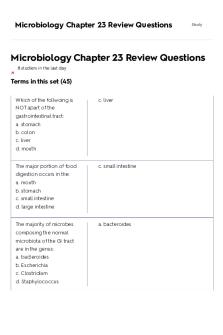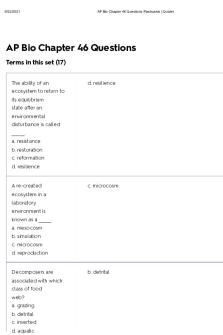Microbiology Chapter 23 Review Questions Flashcards Quizlet PDF

| Title | Microbiology Chapter 23 Review Questions Flashcards Quizlet |
|---|---|
| Course | Microbiology Lecture |
| Institution | Pearl River Community College |
| Pages | 7 |
| File Size | 165.6 KB |
| File Type | |
| Total Downloads | 58 |
| Total Views | 153 |
Summary
Microbiology study materials from lecture, test study guide...
Description
Microbiology Chapter 23 Review Questions
Study
Microbiology Chapter 23 Review Questions 8 studiers in the last day
Terms in this set (45) Which of the follwoing is
c. liver
NOT apart of the gastrointestinal tract: a. stomach b. colon c. liver d. mouth The major portion of food
c. small intestine
digestion occurs in the: a. mouth b. stomach c. small intestine d. large intestine The majority of microbes composing the normal microbiota of the GI tract are in the genus: a. bacteroides b. Escherichia c. Clostridium d. Staphylococcus
a. bacteroides
Microbiology Chapter 23 Review Questions of tooth decay becuase they: a. are acidic and destroy tooth enamel b. are acidic and destroy gingiva c. are converted to acids by bacteria; the acid then destroys tooth enamel d. are converted to acids by bacteria; the acid then detsroys the gingiva
Which of the following is a virulence factor important to Helicobacter pylori during the formation of ulcers: a. type III secretion system b. capsule formation c. flagella d. spore formation
c. flagella
Study
Microbiology Chapter 23 Review Questions pylori by: a. increasing acid production by cells lining the stomach b. neutralizing acid produced by cells lining the stomach c. degrading mucus producing cells d. preventing destruction of H. pylori following phagocytosis
Which causative agent of
a. campylobacter
bacterial gastroenteritis is most commonly seen by doctors in the US: a. campylobacter b. vibrio cholerae c. salmonella serotype typhi d. shigella spp Fever blisters are most often caused by: a. HBV b. HCV c. HHV-1 d. HHV-2
c. HHV-1
Study
Microbiology Chapter 23 Review Questions are due to: a. destruction of liver cells by virus b. cellular immune reactions against infected liver cells c. exotoxin production d. endotoxin production
One of the more common
c. giardiasis
waterbourne gastrointestinal diseases seen in the US is: a. amebiasis b. E. coli O157:H7 c. giardiasis d. salmonellosis Which of the following diseases is an indicator disease signaling that an HIV - positive individual has progressed to AIDS: a. amebiasis b. cryptosporidiosis c. pinworm d. shigellosis
b. cryptosporidiosis
Study
Microbiology Chapter 23 Review Questions b. protozoan c. cestode d. nematode
Which microbial group
a. bacteria
contributes the greatest number of causative agents to overall digestive tract diseases in the United States: a. bacteria b. helminths c. protozoa d. viruses Typhoid fever is caused by
d. salmonellosis
a genus of bacteria that also causes: a. cholera b. cryptosporidiosis c. mumps d. salmonellosis Frothy, greasy diarrhea is caused by: a. Eshcherichia b. Salmonella c. Giardia d. Helicobacter
c. Giardia
Study
Microbiology Chapter 23 Review Questions :but does not" contribute to periodontal disease.
T/F: "Stress" contributes to
FALSE: H. pylori
the formation of peptide ulcers. T/F: Campylobacter jejuni
TRUE
and E. coli are both causative agents of gastroenteritis, but only E. coli is an example of a "coliform". T/F: Proper treatment of
TRUE
most forms of gastroenteritis "does not require" firm laboratory confirmation and identification of the causative agent. T/F: Viral gastroenteritis is generally "more severe" than bacterial gastroenteritis.
FALSE: less severe
Study
Microbiology Chapter 23 Review Questions "HBV infection". T/F: Giardiasis is a common
FALSE: protozoan
"bacterial" infection of the digestive tract. T/F: Cryptosporidosis has
TRUE
"been proven" to affect humans as well as livestock. T/F: Vaccines are available
FALSE: Hepatitis A
against Hepatitis B and "Hepatitis C" T/F: Vibrio cholerae forms
TRUE
biofilms in "seawater" but NOT in "freshwater". Teeth are composed of
1. enamel
three main layers, a hard
2. dentin
layer called ________
3. pulp
overlying the softer _________ and the inner _______ The most common
Streptococcus mutans (viridans
bacterium involved in
streptocuccus)
cavity formation is ______
Study...
Similar Free PDFs

Chapter 23 Review Questions
- 23 Pages

Chapter 7 Flashcards Quizlet
- 8 Pages

Chapter 8 Flashcards Quizlet
- 11 Pages

Chapter 9 Flashcards Quizlet
- 7 Pages

Chapter 16 Flashcards Quizlet
- 4 Pages

Chapter 19 Flashcards Quizlet
- 4 Pages

Review C 1 Flashcards Quizlet
- 82 Pages

Quizlet - Flashcards
- 6 Pages

Chapter 20 465 Flashcards Quizlet
- 40 Pages

Quizlet - flashcards
- 3 Pages
Popular Institutions
- Tinajero National High School - Annex
- Politeknik Caltex Riau
- Yokohama City University
- SGT University
- University of Al-Qadisiyah
- Divine Word College of Vigan
- Techniek College Rotterdam
- Universidade de Santiago
- Universiti Teknologi MARA Cawangan Johor Kampus Pasir Gudang
- Poltekkes Kemenkes Yogyakarta
- Baguio City National High School
- Colegio san marcos
- preparatoria uno
- Centro de Bachillerato Tecnológico Industrial y de Servicios No. 107
- Dalian Maritime University
- Quang Trung Secondary School
- Colegio Tecnológico en Informática
- Corporación Regional de Educación Superior
- Grupo CEDVA
- Dar Al Uloom University
- Centro de Estudios Preuniversitarios de la Universidad Nacional de Ingeniería
- 上智大学
- Aakash International School, Nuna Majara
- San Felipe Neri Catholic School
- Kang Chiao International School - New Taipei City
- Misamis Occidental National High School
- Institución Educativa Escuela Normal Juan Ladrilleros
- Kolehiyo ng Pantukan
- Batanes State College
- Instituto Continental
- Sekolah Menengah Kejuruan Kesehatan Kaltara (Tarakan)
- Colegio de La Inmaculada Concepcion - Cebu





